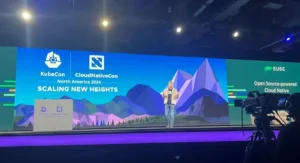New versions of Apache’s distributed NoSQL database management platform and its Java application server were unveiled today at ASF’s Community Over Code event.

Today in Denver at Community Over Code, the Apache Foundation conference that used to be called ApacheCon, two ASF projects announced new releases.
One of the new releases is Cassandra 5.0, which is Apache’s distributed NoSQL database management platform. The other new release is Tomcat 11.0, which comes on something of a birthday for the Java application server project. Today marks 25 years since the first commit to Tomcat’s source code after the project became part of ASF’s porfolio.
About Tomcat 11.0

Tomcat came to Apache in 1999 as a donation from Sun Microsystems, which had developed the software as the reference implementation of the Java Servlet and Java Server Pages specifications. This new release is the ninth major release of the software as an ASF project. Tomcat’s release cycle aligns with each new release of the Servlet specification, ensuring that Tomcat users have access to new specification’s features as they are released.
“One of the many reasons that Tomcat remains popular is that, wherever possible, new features are back-ported to all currently supported versions,” Mark Thomas, a Tomcat project management committee member said in a statement announcing the release.
Developers do like using it. It’s lightweight with fast startup times and it sips resources, so it can be used in a variety environments with minimal impact on resources. When JetBrains conducted a survey last year for its State of Developer Ecosystem 2023 report, it found that 60% of the respondents who identified themselves as developers regularly use Tomcat as their chosen application server.
Tomcat 11.0’s new features and highlights include:
- Virtual thread support to enable applications to scale more easily to meet larger workloads.
- Automatic reloading of updated TLS keys and certificates with zero downtime, allowing easy integration with LetsEncrypt and significantly simplifying the process to renew TLS certificates.
- Support for utilizing OpenSSL for TLS via Java’s new FFM API, which provides a more reliable and easy to use mechanism for integrating Tomcat with OpenSSL.
Dev teams adopting the new release are also not going to have worry about being rushed to upgrade any time soon. As with previous major releases of Tomcat, the new release will be supported for 10 years. Keeping it bug free and secure should also be easy: Tomcat follows a monthly release cycle that include any bug fixes validated since the previous release.
The new version can be downloaded from Apache’s Tomcat 11 Software Downloads page.
About Apache Cassandra 5.0

Cassandra was initially developed at Facebook to be used as part of the function to search inboxes. The software was made open source in 2008 and in 2009 it became an Apache Incubator project that graduated to become a top-level project in 2010.
As a NoSQL database platform, Cassandra is designed to handle large amounts of data across load-intensive applications — with high availability and no single point of failure. It’s been battle tested over the years by being used in numerous critical production deployments by outfits like Apple, Netflix, Huawei, Walmart, and others.
Apache is also confident that the new version is shipping with no major bugs waiting to emerge as unexpected gotchas down the road. It says that the project’s community has rigorously tested this release, using methods that include property-based testing, fault injection, and extensive performance benchmarking.
“Apache Cassandra 5.0 represents a significant leap forward in distributed database technology,” Dinesh Joshi, the chairperson and vice president of the project said in a statement. “This release brings groundbreaking features that enhance performance and scalability and position Cassandra at the forefront of AI-driven data management.”
It also brings new capabilities to the table as well as improvements that will improve the experience for DevOps teams dependent on the software, including:
- Storage Attached Indexes: Revolutionizes query flexibility and performance, especially for large datasets, allowing for more efficient and versatile data retrieval.
- Trie Memtables and Trie SSTables: Optimizes memory and storage usage, significantly improving database performance without requiring changes to existing data models.
- Unified Compaction Strategy: Enhances operational efficiency by automatically adapting to changing requirements, reducing manual intervention in data organization.
- Vector Search: Introduces native support for artificial intelligence (AI) and machine learning applications, enabling semantic search capabilities crucial for next-generation applications.
- JDK 17 Support: Upgrades to Java Development Kit 17, bringing substantial performance improvements and new language features.
- Dynamic Data Masking: Enhances data security by allowing sensitive information to be obscured dynamically during queries without altering the stored data.
- Mutual TLS Authentication: Brings certificate based authentication and authorization to Apache Cassandra allowing the users to authenticate with no passwords required.
“With features like Storage Attached Indexes and Vector Search, we’re not just improving performance, we’re opening up new possibilities for how organizations can leverage their data in the age of AI,” Patrick McFadin, an Apache Cassandra committer said.
For downloads, documentation, and other information, visit the Apache Cassandra website.
Christine Hall has been a journalist since 1971. In 2001, she began writing a weekly consumer computer column and started covering Linux and FOSS in 2002 after making the switch to GNU/Linux. Follow her on Twitter: @BrideOfLinux









